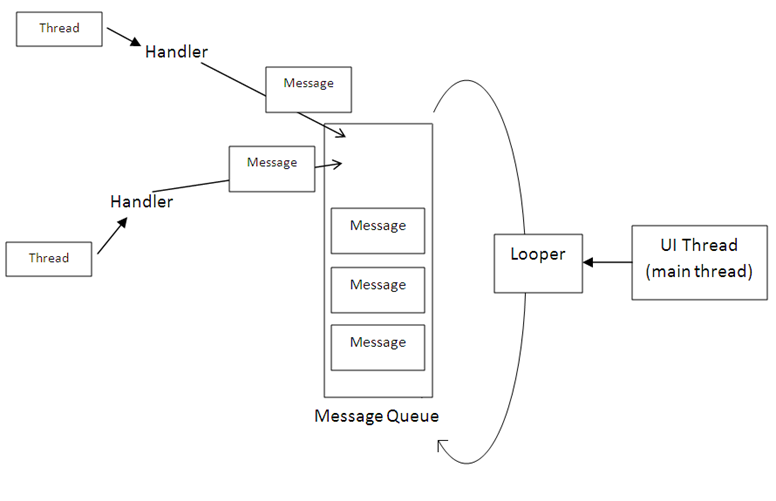Android系统的消息队列和消息循环都是主线程的,其它后台服务等无法直接更新,必须通过下面的消息队列,由主线程的消息循环去依次执行更新ui;
同时对于费时间超过5秒的事件,比如网络链接等,建议新开线程处理,否则系统会提示用户终止你。
扩招知识:
Android系统的消息队列和消息循环都是针对具体线程的,一个线程可以存在(当然也可以不存在)一个消息队列(Message Queue)和一个消息循环(Looper)。Android中除了UI线程(主线程),创建的工作线程默认是没有消息循环和消息队列的。如果想让该线程具有消息队列和消息循环,并具有消息处理机制,就需要在线程中首先调用Looper.prepare()来创建消息队列,然后调用Looper.loop()进入消息循环。如以下代码所示:
- class LooperThread extends Thread {
- public Handler mHandler;
- public void run() {
- Looper.prepare();
- mHandler = new Handler() {
- public void handleMessage(Message msg) {
- // process incoming messages here
- }
- };
- Looper.loop();
- }
- }
- class LooperThread extends Thread {
- public Handler mHandler;
- public void run() {
- Looper.prepare();
- mHandler = new Handler() {
- public void handleMessage(Message msg) {
- // process incoming messages here
- }
- };
- Looper.loop();
- }
- }
这样该线程就具有了消息处理机制了。如果不调用Looper.prepare()来创建消息队列,会报"java.lang.RuntimeException: Can't create handler inside thread that has not called Looper.prepare()"的错误。
通过下图可以清晰显示出UI Thread, Worker Thread, Handler, Massage Queue, Looper之间的关系:

如上图: UI Thread, Worker Thread, Handler, Massage Queue, Looper之间的关系
上图中的几个基本概念:
1.Message
消息对象,顾名思义就是记录消息信息的类。这个类有几个比较重要的字段:
a.arg1和arg2:我们可以使用两个字段用来存放我们需要传递的整型值,在Service中,我们可以用来存放Service的ID。
b.obj:该字段是Object类型,我们可以让该字段传递某个多项到消息的接受者中。
c.what:这个字段可以说是消息的标志,在消息处理中,我们可以根据这个字段的不同的值进行不同的处理,类似于我们在处理Button事件时,通过switch(v.getId())判断是点击了哪个按钮。
在使用Message时,我们可以通过new Message()创建一个Message实例,但是Android更推荐我们通过Message.obtain()或者Handler.obtainMessage()获取Message对象。这并不一定是直接创建一个新的实例,而是先从消息池中看有没有可用的Message实例,存在则直接取出并返回这个实例。反之如果消息池中没有可用的Message实例,则根据给定的参数new一个新Message对象。通过分析源码可得知,Android系统默认情况下在消息池中实例化10个Message对象。
2.MessageQueue
消息队列,用来存放Message对象的数据结构,按照“先进先出”的原则存放消息。存放并非实际意义的保存,而是将Message对象以链表的方式串联起来的。MessageQueue对象不需要我们自己创建,而是有Looper对象对其进行管理,一个线程最多只可以拥有一个MessageQueue。我们可以通过Looper.myQueue()获取当前线程中的MessageQueue。
3.Looper
MessageQueue的管理者,在一个线程中,如果存在Looper对象,则必定存在MessageQueue对象,并且只存在一个Looper对象和一个MessageQueue对象。倘若我们的线程中存在Looper对象,则我们可以通过Looper.myLooper()获取,此外我们还可以通过Looper.getMainLooper()获取当前应用系统中主线程的Looper对象。在这个地方有一点需要注意,假如Looper对象位于应用程序主线程中,则Looper.myLooper()和Looper.getMainLooper()获取的是同一个对象。
4.Handler
消息的处理者。通过Handler对象我们可以封装Message对象,然后通过sendMessage(msg)把Message对象添加到MessageQueue中;当MessageQueue循环到该Message时,就会调用该Message对象对应的handler对象的handleMessage()方法对其进行处理。由于是在handleMessage()方法中处理消息,因此我们应该编写一个类继承自Handler,然后在handleMessage()处理我们需要的操作。
另外,我们知道,Android UI操作并不是线程安全的,所以无法在子线程中更新UI。但Andriod提供了几种方法,可以在子线程中通知UI线程更新界面:
- Activity.runOnUiThread( Runnable )
- View.post( Runnable )
- View.postDelayed( Runnable, long )
- Handler
比较常用的是通过Handler,用Handler来接收子线程发送的数据,并用此数据配合主线程更新UI。那么,只要在主线程中创建Handler对象,在子线程中调用Handler的sendMessage方法,就会把消息放入主线程的消息队列,并且将会在Handler主线程中调用该handler的handleMessage方法来处理消息。
- package com.superonion;
- import android.app.Activity;
- import android.os.Bundle;
- import android.os.Message;
- import android.util.Log;
- import android.os.Handler;
- public class MyHandler extends Activity {
- static final String TAG = "Handler";
- Handler h = new Handler(){
- public void handleMessage (Message msg)
- {
- switch(msg.what)
- {
- case HANDLER_TEST:
- Log.d(TAG, "The handler thread id = " + Thread.currentThread().getId() + " ");
- break;
- }
- }
- };
- static final int HANDLER_TEST = 1;
- /** Called when the activity is first created. */
- @Override
- public void onCreate(Bundle savedInstanceState) {
- super.onCreate(savedInstanceState);
- Log.d(TAG, "The main thread id = " + Thread.currentThread().getId() + " ");
- new myThread().start();
- setContentView(R.layout.main);
- }
- class myThread extends Thread
- {
- public void run()
- {
- Message msg = new Message();
- msg.what = HANDLER_TEST;
- h.sendMessage(msg);
- Log.d(TAG, "The worker thread id = " + Thread.currentThread().getId() + " ");
- }
- }
- }
- package com.superonion;
- import android.app.Activity;
- import android.os.Bundle;
- import android.os.Message;
- import android.util.Log;
- import android.os.Handler;
- public class MyHandler extends Activity {
- static final String TAG = "Handler";
- Handler h = new Handler(){
- public void handleMessage (Message msg)
- {
- switch(msg.what)
- {
- case HANDLER_TEST:
- Log.d(TAG, "The handler thread id = " + Thread.currentThread().getId() + " ");
- break;
- }
- }
- };
- static final int HANDLER_TEST = 1;
- /** Called when the activity is first created. */
- @Override
- public void onCreate(Bundle savedInstanceState) {
- super.onCreate(savedInstanceState);
- Log.d(TAG, "The main thread id = " + Thread.currentThread().getId() + " ");
- new myThread().start();
- setContentView(R.layout.main);
- }
- class myThread extends Thread
- {
- public void run()
- {
- Message msg = new Message();
- msg.what = HANDLER_TEST;
- h.sendMessage(msg);
- Log.d(TAG, "The worker thread id = " + Thread.currentThread().getId() + " ");
- }
- }
- }
以上代码中,Handler在主线程中创建后,子线程通过sendMessage()方法就可以将消息发送到主线程中,并在handleMessage()方法中处理。